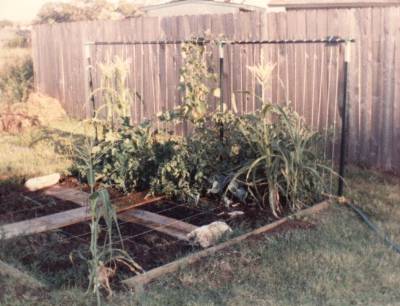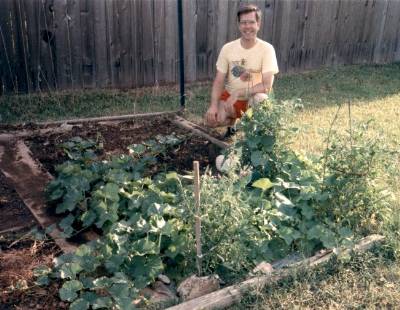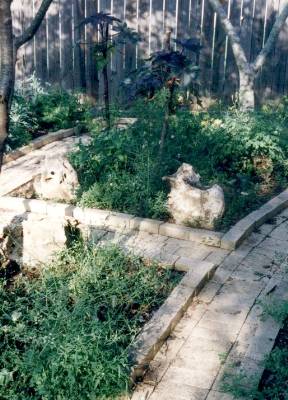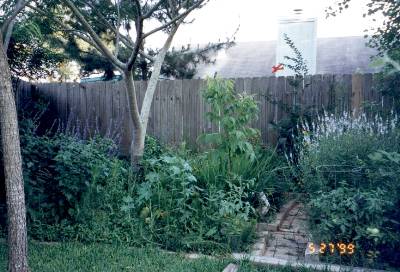Garden Gallery 8
Back Corner Garden
|
The far southeast corner of our yard has been the site of an active garden since very shortly after we moved in. The form of this garden has changed drastically, and so have the plants, but it has always held our interest.
Larry had read a book called Square Foot Gardening and decided to apply the techniques to a vegetable garden in this location. The above photo was taken in 1988. The boards were necessary because the clay soil became a quagmire whenever it was wet.
The makeshift trellis, shown above in 1988, gave support to vines and tomato plants that got too tall. The rocks that had started as corner anchors were soon needed to keep the warping boards semi flat.
Above, Larry poses with the bounty produced in 1989. That year we tried cantalope. They had a disagreeable metallic flavor. We almost always planted tomatoes and many would split in the heat or be damaged by birds and disease. It was also becoming apparent that the garden needed a terrific amount of water and did not produce all that much.
Over the next few years, we nearly abandoned the vegetables and began to use the area for piles of leaves and other compost. During heavy rains, the entire corner flooded. We still planted a few things, but never really planned out a garden until 1994. At this time, we decided to create something more formal, with brick walkways and defined beds. The photo above shows the beginning stage of construction. The garden was to occupy the entire space between the new compost bins and the back and side fences. The focal point was a 4-trunked sumac that we had found dumped on the side of the road a few blocks away. We walked over with a wheelbarrow and brought it home.
By around 1996, the new garden was filled with plants which received a nice mix of morning sun and afternoon shade. The brick borders proved adequate to keep the beds safe during flooding, with the water channeling along the paths as if in canals. A small lake would form in the very corner of the garden and this area was left as a place to dump fresh soil removed from the compost bins. Plants in the above photo include castor bean, carrots (white flowers), and a mix of various wildflowers. Several of the rocks we dug up became decorations within the garden.
The photo above shows another view of the garden in 1996. The bricks have no mortar between them and are simply laid into the soil, with added sand to help secure them. Over the years, the roots of the trees have deformed the orderly lines of the paths, but they are still quite functional. By this time, there were two shade-providing trees: the sumac (visible in the upper left corner of the picture) and a mimosa (upper right corner).
The above 1999 photo shows the view from next to the compost bins. Some tomato plants are squeezed into the lower right corner, while slender vervain grows upright behind them. The far left side of the garden contains an indigo spires sage. Castor bean and crocosmia are growing in the middle. The tree in the garden is the mimosa and the trunk visible at the near left side of the photo is a willow.
Early in the spring, this garden is not nearly as overgrown as it will become by autumn. The above photo was taken in March, 2003, and shows columbines and baby blue-eyes in bloom. Crocosmia is visible in the center and goldenrod is directly behind it. The dark tangle of tree trunks in the near right area of the garden includes the remaining dead snags from the sumac, as well as a healthy Chinese tallow and a blooming pyracantha. The tallow tree and remaining dead trunks provide support for perennial morning glories which are only starting to grow around the base at this time.
|







